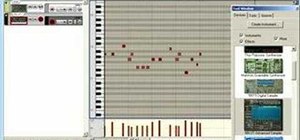

- REASON 6 TUTORIAL HIP HOP HOW TO
- REASON 6 TUTORIAL HIP HOP FULL
- REASON 6 TUTORIAL HIP HOP PRO
- REASON 6 TUTORIAL HIP HOP FREE
REASON 6 TUTORIAL HIP HOP PRO
It's really important to get the elements of your mix balanced together for a pro mix.
REASON 6 TUTORIAL HIP HOP HOW TO
Jay shows you how to structure a typical Hip Hop track. We also look over all our 'ad libs' and 'oohs' and 'yeahs' and start dropping them into various sections of our track to help distinguish the different sections. Next, Jay shows you how to utilize other vocal takes to fatten the main vocal up which makes it sound more like a pro release.

Now you have one good take you'll learn how to pitch and time correct it using in-built tools. Comping is a useful tool making selecting the best bits out of several vocal takes very easy. In section 5 you'll learn how to 'comp' a recorded vocal using Cubase 'lanes'. These elements are slotted specially into our track by using EQ, compression and panning, keeping left / right, up / down, front / back awareness in mind. Continuing with the 90s sounds we add a glockenspiel and electric guitar, commonly used back then. This helps separate the different sections. For example we add a piano for the chorus and a Rhodes electric piano for the pre-chorus.
REASON 6 TUTORIAL HIP HOP FULL
This makes the production more full and also helps with variation and interest. To compete with pro tracks out there we're going to continue adding more elements to fill out the sides and back of the mix. We take ideas from well known producers and use these to influence our track in a positive way. You'll then start adding other melodic orchestral elements with Halion SE such as brass stabs and lo-fi strings to fill out the track and make it sound more in-line with the genre. Using the in-built VST synth Retrologue, Jay shows you how easy it is to make an authentic bass sound and sculpt it accordingly to mix perfectly into your track. Next we move onto the very important bass which along with the kick is equally fundamental to the low end of any Hip Hop track. Now we have the vocals it's onto the bass and other instruments as we can now work out the key of the track. EQ and compression is applied in the mixing lesson. After a bit of AudioWarp and cut and move, you'll have your vocals sitting nicely in time with your beat. Jay shows you several ways to adjust the rap to fit with our beat (as of course they would have been sung with a different beat in mind). Next it's time to import these vocals in but don't forget to timestretch them.
REASON 6 TUTORIAL HIP HOP FREE
Not everyone 'knows' a rapper so Jay shows you where to find copyright free acapellas on the internet.

You'll fill out the drums with a cowbell, 2nd fill kick drum, crash and human clap and learn how to use the sampler track to timestretch elements to fit your track better. 90s beats were often 'off the grid' and were not heavily quantized. EQ and compression is used to attain that 'retro' sound and quantize swing is utilized to give a more 'live' playing feel. As this doesn't take long we start programming in an authentic 90s Hip Hop beat using mostly samples that come with Cubase (anything external is included). Create a Remix 14:2.After a short intro and brief history from your tutor Jay, you'll get straight on with setting up Cubase. First off, when we build a combinator, we need a mixer.


 0 kommentar(er)
0 kommentar(er)
